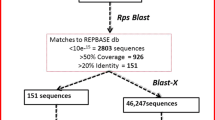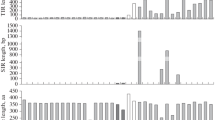Abstract
A member of the Tc1 family of transposable elements has been identified in the Central and South American mosquito Anopheles albimanus. The full-length Quetzal element is 1680 base pairs (bp) in length, possesses 236 bp inverted terminal repeats (ITRs), and has a single open reading frame (ORF) with the potential of encoding a 341-amino-acid (aa) protein that is similar to the transposases of other members of the Tc1 family, particularly elements described from three different Drosophila species. The approximately 10–12 copies per genome of Quetzal are found in the euchromatin of all three chromosomes of A. albimanus. One full-length clone, Que27, appears capable of encoding a complete transposase and may represent a functional copy of this element.
Similar content being viewed by others
References
avancini, R.M.P., K.K.O. Walden & H.M. Robertson, 1996. The genomes of most animals have multiple members of the Tc1 family of transposable elements. Genetica (in press).
Beach R.F., D. Mills & F.H. Collins, 1989. The structure of ribosomal DNA (rDNA) in Anopheles albimanus (Diptera: Culicidae). Ann. Entomol. Soc. Am. 82: 641–648.
Bresinsky L., G.V.L. Wang, T. Humphreys & J. Hung, 1990. The transposable element Uhu from Hawaiian Drosophila-member of the widely dispersed class of Tc1-like transposons. Nucleic Acids Res. 18: 2053–2059.
Caizzi R., C. Caggese & S. Pimpinelli, 1993. Bari-1: a new transposon-like family in Drosophila melanogaster with a unique heterochromatic organization. Genetics 133: 335–345.
Collins F.H., M.A. Mendez, M.O. Rasmussen, P.C. Mchaffey, N.J. Besansky & V. Finnerty, 1987. A ribosomal RNA gene probe differentiates member species of the Anopheles gambiae complex. Am. J. Trop. Med. Hyg. 37: 37–41.
Collins F.H. & N.J. Besansky, 1994. Vector biology and the control of malaria in Africa. Science 264: 1874–1875.
Doak T.G., F.P. Doerder, C.L. Jahn & G. Herrick, 1994. A proposed superfamily of transposase genes: Transposon-like elements in ciliated protozoa and a common “D35E” motif. Proc. Natl. Acad. Sci. USA. 91: 942–946.
Franz G. & C. Savakis, 1991. Minos, a new transposable element from Drosophila hydel, is a member of the Tc1-like family of transposons. Nucleic Acids Research 19: 6646.
Genetics Computer Group, 1994. Program Manual for the CCC Package, Version 8.0, 575 Science Drive, Madison, WI 53711, USA.
Gehring W.J., 1992. The homeobox in perspective. Trends Biochem. Sci. 17: 277–280.
Goodier J.L. & W.S. Davidson, 1994. Te1 transposon-like sequences are widely distributed in salmonids. J. Mol. Biol. 241: 26–34.
Henikoff S., 1992. Detection of Caenorhabditis transposon homologs in diverse organisms. New Biol. 4: 382–388.
Kumar V. & F.H. Collins, 1994. A technique for nucleic acid in situ hybridization to polytene chromosomes of mosquitoes in the Anopheles gambiae complex. Insect Mol. Biol. 3: 41–47.
Langin T., P. Capy & M. Daboussi, 1995. The transposable element impala, a fungal member of the Tc1-mariner superfamily. Mol. Gen. Genet. 246: 19–28.
Langley C.H., E.A. Montgomery, R. Hudson, N.L. Kaplan & B. Charlesworth, 1988. On the role of unequal exchange in the containment of transposable element copy number. Genet. Res. 52: 223–236.
Loukeris T.G., L. Ioannis, B. Arca, S. Zabalou & C. Savakis, 1995. Gene transfer into the Medfly, Ceratitis capitata, with a Drosophila hydei transposable eiement. Science 270: 2002–2005.
Merriman P.J., C.D. Grimes, J. Ambroziak, F.S. Hackett & M.J. Simmons, 1995. S elements: A family of Tc1-like transposons in the genome of Drosophila melanogaster. Genetics 141: 1425–1438.
Miller L.H., R.K. Sakai, P. Romans, R.W. Gwadz, P. Kantoff & H.G. Coon, 1987. Stable integration and expression of a bacterial gene in the mosquito Anopheles gambias, Science 237: 779–781.
O'Brochta D.A., W.D. Warren, K.J. Savile & P.W. Atkinson, 1996. Hermes, a functional non-Drosophilid insect gene vector from Musca domestica. Genetics 142: 907–914.
Petrov D.A., J.L. Schutzman, D.L. Hartl & E.R. Lozovskays, 1995. Diverse transposable elements are mobilized in hybrid dysgenesis in Drosophila virilis. Proc. Natl. Acad. Sci. USA. 92: 8050–8054.
Radice A.D., B. Bugaj, D.H.A. Fich & S.W. Emmons, 1994. Widespread occurrence of the Tc1 transposons from teleost fish. Mol. Gen. Genet. 244: 606–612.
Robertson H.M. 1995. The Tc1-mariner superfamily of transposons in animals. J. Inseet Physiol. 41: 99–105.
Robertson H.M. & D.J. Lampe, 1995. Diatribution of transposable elements in arthropods. Annu. Rev. Entomol. 40: 333–357.
Rosenzweig B., L.W. Liao & D. Hirsh, 1983. Sequence of the C. elegans transposable element Tc1. Nucleic Acids Research. 11: 4201–4209.
Saitou N & M. Nei, 1987. The neighbor-joining method: a new method for reconstructing phylogenetic trees. Mol. Biol. and Evol. 4: 406–425.
Sambrook J., E.F. Fritsch & T. Manlatis, 1989. Molecular Cloning: A Laboratory Manual. Cold Spring Habor Laboratory. Cold Spring Habor, N.Y.
Sarasts M., P.R. Sibbald & A. Wittinghofer, 1990. The P-loop—a common rootif in ATP- and GTP-binding proteins. Trends in Biochemical Sciences. 15: 430–434.
Van Leunen H.G.A.M. & R.H.A. Plasterk, 1994. Target site choice of the related transposable elements Tc1 and Tc3 of Caenorhabditis elegans. Nucleic Acids Research 22: 262–269.
Vos J.C., H.G.A.M.Van Leunen & R.H.A. Plasterk, 1993. Characterization of the Caenorhabditis elegans Tc1 transposase in vivo and in vitro. Genes & Development 7: 1244–1253.
Vos I.C., I.D. Baene & R.H.A. Plasterk, 1996. Transposase is the only nematode protein required for in vitro transposition of Tc1. Genes & Development 10: 755–761.
Author information
Authors and Affiliations
Rights and permissions
About this article
Cite this article
Ke, Z., Grossman, G.L., Cornel, A.J. et al. Quetzal: a transposon of the Tc1 family in the mosquito Anopheles albimanus . Genetica 98, 141–147 (1996). https://doi.org/10.1007/BF00121362
Received:
Accepted:
Issue Date:
DOI: https://doi.org/10.1007/BF00121362




